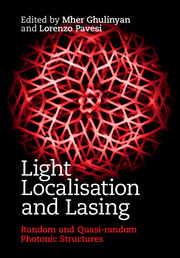Book contents
- Frontmatter
- Contents
- List of contributors
- Preface
- 1 Light propagation and emission in complex photonic media
- 2 Transport of localized waves via modes and channels
- 3 Modes structure and interaction in random lasers
- 4 Ordered and disordered light transport in coupled microring resonators
- 5 One-dimensional photonic quasicrystals
- 6 2D pseudo-random and deterministic aperiodic lasers
- 7 Three-dimensional photonic quasicrystals and deterministic aperiodic structures
- 8 Cavity quantum electrodynamics with three-dimensional photonic band gap crystals
- References
- Index
6 - 2D pseudo-random and deterministic aperiodic lasers
Published online by Cambridge University Press: 18 December 2014
- Frontmatter
- Contents
- List of contributors
- Preface
- 1 Light propagation and emission in complex photonic media
- 2 Transport of localized waves via modes and channels
- 3 Modes structure and interaction in random lasers
- 4 Ordered and disordered light transport in coupled microring resonators
- 5 One-dimensional photonic quasicrystals
- 6 2D pseudo-random and deterministic aperiodic lasers
- 7 Three-dimensional photonic quasicrystals and deterministic aperiodic structures
- 8 Cavity quantum electrodynamics with three-dimensional photonic band gap crystals
- References
- Index
Summary
Introduction
Unlike a conventional laser which utilizes mirrors or periodic structures to trap light, a random laser relies on the multiple scattering of light in a disordered gain medium for optical feedback and light confinement (see Figure 6.1) [67, 70, 528, 529]. Coherent laser emission has been generated from various random structures ranging from semiconductor nanoparticles and nanorods to polymers and organic materials. Over the past decade, random lasers have generated significant interest among researchers because of their unique applications [67, 529]. For example, specifically designed random lasers combine high radiance with low spatial coherence [357, 403], ideally suited for speckle-free, parallel, high-speed imaging, laser projection and ranging [404]. The sensitivity of the random lasing threshold to the amount of scattering has been explored for cancerous tissue mapping [387, 389]. Moreover, the spectral fingerprint of the random structure [70, 71], the micron size [70], the low fabrication cost, and the robustness against surface roughness and shape deformation point to potential applications in optical tagging and identification [528]. Since random laser cavities are formed by scattering and are much easier to fabricate compared with the mirror-based cavities, they may be applied to lasers at wavelengths where high-reflectivity mirrors are either not available or very expensive, e.g. UV laser, X-ray laser, γ-ray laser. A detailed description of random lasers can be found in Chapter 3.
However, a major limitation to device applications of random lasers is the lack of control and reproducibility of lasing modes. Namely, the frequencies and spatial locations of lasing modes are unpredictable, varying randomly from sample to sample. One way to solve this problem is to utilize pseudo-random structures, or more generally, deterministic aperiodic nanostructures (DANS) [98]. Unlike structures generated by a random process, DANS are generated by the iteration of simple mathematical rules with a controllable degree of spatial complexity that interpolates between periodic and random systems. DANS lasers can combine the advantages of random lasers with the fabrication and design reproducibility required for optoelectronics integration.
- Type
- Chapter
- Information
- Light Localisation and LasingRandom and Pseudo-random Photonic Structures, pp. 130 - 145Publisher: Cambridge University PressPrint publication year: 2014



